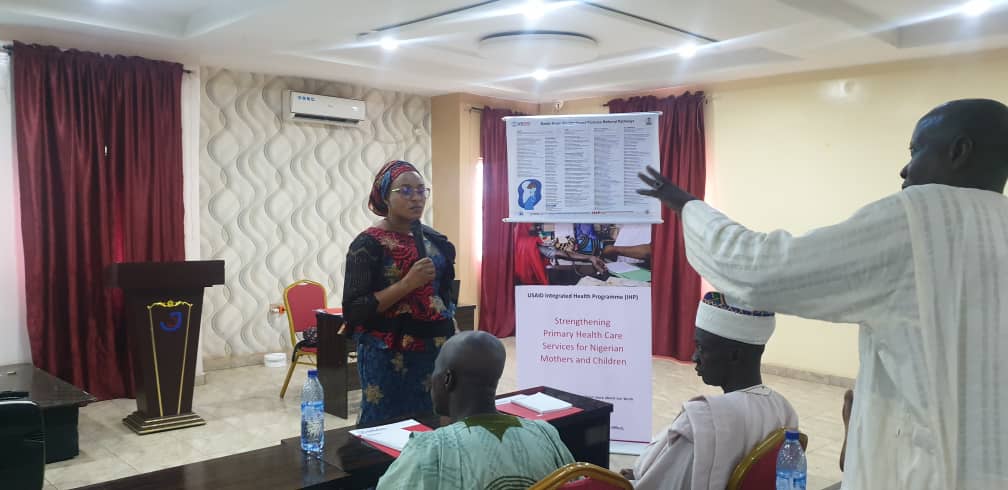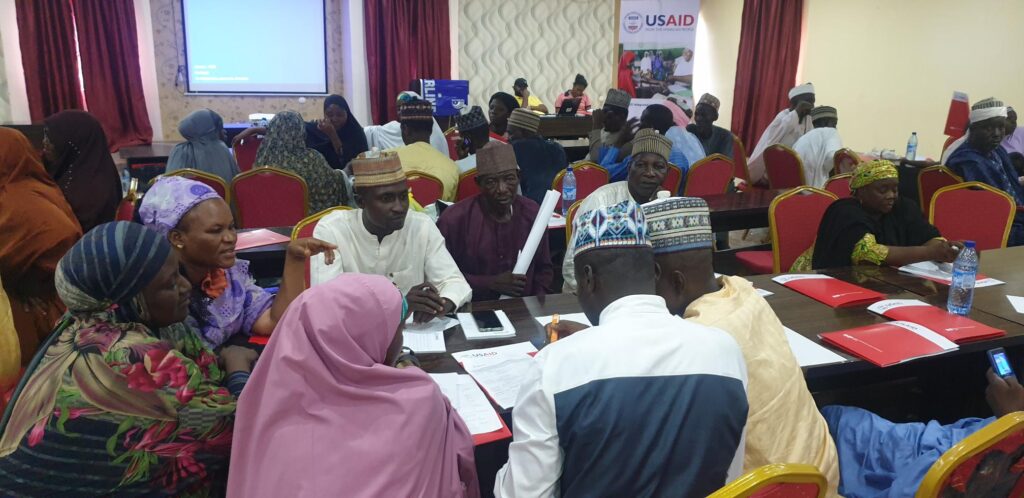Improving Survivor-Centered Care Through a Coordinated Response to Gender-Based Violence in Kebbi State, Nigeria
By Stella Abah, WI-HER Gender, Social Inclusion, and Community Engagement (GSI&CE) Advisor; Dr. Adamu Nuhu, USAID IHP Kebbi Director; and Shauna-Kaye, WI-HER Senior Associate

Gender-based violence (GBV) is a multi-faceted and complex issue; it is a violation of a person’s basic human rights and its consequences can negatively impact a person’s quality of life. Its impact is far-ranging, affecting not only the physical and emotional health of an individual but also the health of their larger community, particularly women, who make up the lion’s share of victims, according to the International Medical Corps. Experiences drawn from program implementation reveal that addressing GBV prevention, mitigation, and response requires a multisectoral approach, especially during referral, as a single survivor may require multiple referral points when they seek out immediate and follow-up longer-term GBV care.
A multi-sectoral response to GBV should include a holistic and coordinated approach aimed at ensuring that the services required to inform, treat, and provide post-treatment care—such as making the appropriate referrals for additional medical care or social support services—are available to GBV survivors, while also working to prevent revictimization. Institutions operating within the areas of health care services, the security forces, and other social services, such as the provision of housing, and the retention of legal services, must work together to ensure that the quality of care is improved, address issues related to low reporting of GBV–including stigma, and develop solutions to address their own capacity in appropriately treating GBV survivors.
Challenges identified within a Gender, Youth, and Social Inclusion (GYSI) Analysis under USAID IHP
While multi-sectoral coordination is critical in GBV response, it previously did not exist in Kebbi State, Nigeria. Rather, Nigeria historically focused on a traditional model of addressing GBV where various entities provided services to GBV survivors but did not work in coordination with one another (i.e., they did not make referrals to other services). In part, this lack of coordination existed due to a lack of knowledge among healthcare workers of the various agencies available to GBV survivors and no pathway to share information and report to a central data point. Multiple, uncoordinated entry points for GBV survivors further aggravated these challenges, which in turn, resulted in a set of services that were not comprehensive enough to meet the complex needs of GBV survivors; for example, services where a survivor can receive immediate medical attention, first-line support (including mental health and psychosocial support), and referrals to social services such as legal aid, housing solutions, and livelihood support.

To better understand these challenges, WI-HER, a partner of the USAID-funded Integrated Health Program (IHP) in Nigeria, conducted an initial gender and social inclusion analysis in 2020. Findings from this analysis confirmed that the absence of an integrated GBV approach, along with statistical inaccuracies in the data provided and poor documentation/information collected on the client, significantly impacted the quality of immediate and post-care services that GBV survivors received. This uncoordinated and lack of a comprehensive response often contributed to recurrent physical and mental health issues, with survivors experiencing depression, suicidal thoughts, and post-traumatic stress disorder (PTSD).
Furthermore, the analysis revealed limited knowledge and capacity amongst the institutions within the GBV space. For example, NGOs and other local organizations or entities who worked to address GBV lacked the capacity for activities around community sensitization around the risks, prevalence, and harmful outcomes associated with GBV. They also did not offer adequate and full support services, including screening, identification, and documentation of GBV cases and referral, for example, for legal support.
How USAID IHP fostered coordination among sectors and agencies to improve GBV response
Based on the gaps identified in the GYSI analysis, WI-HER set out to address the lack of multisectoral coordination through various activities in Kebbi state, Nigeria, including establishing a State GBV Technical Working Group (GBV TWG). In 2022, the GBV TWG took part in a two-day capacity development workshop on multisectoral GBV response, which included the mapping of available GBV service providers in health care, social welfare, legal activities, security, and community services, including community sensitization, advocacy visits, and media engagement.
After completing the mapping exercise, the IHP Gender, Social Inclusion & Community Engagement Advisor for Kebbi, in collaboration with Kebbi stakeholders—the State Ministry of Health (SMoH) & the Ministry of Women Affairs and Social Development (MOWASD)—developed and disseminated a robust, first-of-its-kind GBV service directory/referral pathway, which is a job aid that contains the details of each identified GBV service provider in the state, including the services they provide. The GBV referral service directory effectively provides service providers with tools to inform survivors about the available services related to GBV care and treatment, including where to access these services.
In conducting the aforementioned activities, WI-HER, through IHP and the MOWASD, designed a multisector model that provides a visual tool for healthcare workers as well as a system for interagency response. By creating the GBV service directory and referral pathway, healthcare workers can now easily link or refer GBV survivors to various services for case management or services based on each survivor’s needs.
Capacity building on the GBV referral service directory
IHP also organized training activities to build the capacity of frontline healthcare workers through the introduction and operationalization of the referral pathways. Moreover, WI-HER, through IHP and in collaboration with the Ministry of Health, supported the State through a Grants Under Contract (GUC) mechanism to build the capacity of over 600 Primary Health Care (PHC) staff, including nurses, administrators, security personnel, and the legal team, in clinical and non-clinical skills through facilitating training sessions on related GBV issues along with treatment and support needs. This included building the capacity of PHC staff to provide first-line response using Listening, Inquire, Validate, Enhance Safety, and Support (LIVES) skills to support survivors of GBV, as well as ensuring that the documentation requirements were understood and put into practice.
The Impact of a Multisectoral GBV Response on Health Workers and Survivors
The enhanced coordination efforts, including the development of the referral pathway, have been greatly appreciated by all stakeholders. As one of the GUC training participants, Hassan Kwaido, shared, “The creation of the referral pathways has improved information sharing among sectors. Everyone now knows what to do and when to refer a survivor for further care and service. I am really happy with the results and support we received from USAID IHP, Kebbi. For me, it is like a renewal of oath in service.”
Moreover, the multi-sectoral GBV response has led to an increased level of safety and support in the provision of services for GBV survivors now that those involved in the GBV response understand how the referral pathways should be utilized. One of the survivors shared her thoughts and experience: “I was referred here (Social Welfare) by someone from my community. She told me that I will be supported, and I am so grateful for the love and support I received. I was offered shelter for me and my three children. I received adequate medical attention. We were fed daily, and they equally ensured my wards attended school on daily basis. Words cannot express my gratitude to you all.”
Prior to the initiative launch in 2020, less than 200 GBV cases were reported by the SMoH. As a result of improving the capacity of frontline healthcare workers and the establishment of a coordinated multi-sectoral response to support GBV survivors in Kebbi, via the GUC intervention, the Ministry reported a total of 6,000 GBV cases in 2023 alone, representing an increase of 2,900%
As one of the frontline health workers trained said, “We started from nowhere with GBV identification, documentation and care, now we have huge results to showcase, since IHP developed our capacity.” The multi-sectoral response to GBV has developed and fostered a network of effective and qualitative services that has increased the trust of survivors and their families, effectively improving the health and well-being of survivors.
IHP will continue to strengthen the health system’s response to GBV and advocate for continuous GBV funding prioritization at all levels of government, including health, education, judiciary, and social welfare.